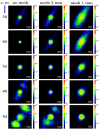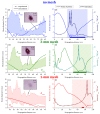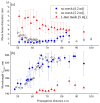Nonlinear Propagation and Filamentation on 100 Meter Air Path of Femtosecond Beam Partitioned by Wire Mesh
- PMID: 36080786
- PMCID: PMC9460567
- DOI: 10.3390/s22176322
Nonlinear Propagation and Filamentation on 100 Meter Air Path of Femtosecond Beam Partitioned by Wire Mesh
Abstract
High-intensity (∼1 TW/cm2 and higher) region formed in the propagation of ∼60 GW, 90 fs Ti:Sapphire laser pulse on a ∼100 m path in air spans for several tens of meters and includes a plasma filament and a postfilament light channel. The intensity in this extended region is high enough to generate an infrared supercontinuum wing and to initiate laser-induced discharge in the gap between the electrodes. In the experiment and simulations, we delay the high-intensity region along the propagation direction by inserting metal-wire meshes with square cells at the laser system output. We identify the presence of a high-intensity region from the clean-spatial-mode distributions, appearance of the infrared supercontinuum wing, and occurrence of the laser-induced discharge. In the case of free propagation (without any meshes), the onset of the high-intensity zone is at 40-52 m from the laser system output with ∼30 m extension. Insertion of the mesh with 3 mm cells delays the beginning of the high-intensity region to 49-68 m with the same ∼30 m extension. A decrease in the cell size to 1 mm leads to both delay and shrinking of the high-intensity zone to 71-73 m and 6 m, respectively. Three-dimensional simulations in space confirm the mesh-induced delay of the high-intensity zone as the cell size decreases.
Keywords: beam regularization; femtosecond filamentation; infrared supercontinuum; remote discharge triggering.
Conflict of interest statement
The authors declare no conflicts of interest.
Figures






Similar articles
-
Postfilament supercontinuum on 100 m path in air.Opt Lett. 2021 Mar 1;46(5):1125-1128. doi: 10.1364/OL.416224. Opt Lett. 2021. PMID: 33649673
-
Effect of focusing element-induced aberrations on filamentation and supercontinuum emission in ambient air.Opt Express. 2021 May 10;29(10):14668-14681. doi: 10.1364/OE.422508. Opt Express. 2021. PMID: 33985184
-
Supercontinuum generation by co-filamentation of two color femtosecond laser pulses.Sci Rep. 2019 Jun 21;9(1):9011. doi: 10.1038/s41598-019-45357-y. Sci Rep. 2019. PMID: 31227741 Free PMC article.
-
Sensing with Femtosecond Laser Filamentation.Sensors (Basel). 2022 Sep 19;22(18):7076. doi: 10.3390/s22187076. Sensors (Basel). 2022. PMID: 36146424 Free PMC article. Review.
-
Optical spectroscopy using gas-phase femtosecond laser filamentation.Annu Rev Phys Chem. 2014;65:605-28. doi: 10.1146/annurev-physchem-040513-103708. Epub 2014 Jan 9. Annu Rev Phys Chem. 2014. PMID: 24423375 Review.
References
-
- Béjot P., Bonacina L., Extermann J., Moret M., Wolf J.P., Ackermann R., Lascoux N., Salamé R., Salmon E., Kasparian J., et al. 32 TW atmospheric white-light laser. Appl. Phys. Lett. 2007;90:151106. doi: 10.1063/1.2722564. - DOI
Grants and funding
LinkOut - more resources
Full Text Sources
Miscellaneous

